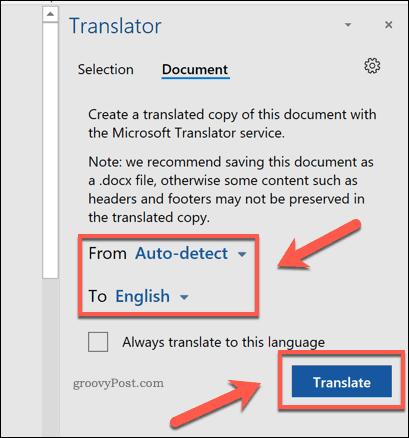

- MICROSOFT WORD IN FRENCH HOW TO CHANGE TO ENGLISH CODE
- MICROSOFT WORD IN FRENCH HOW TO CHANGE TO ENGLISH PLUS
If you want Office to use a particular display language, make sure you check the box under Office display Language. The ç will appear.Įxample 2: To input French Ç ( Shift+Option+C), hold down the Shift key, then the Option key,then the C key. How Do You Change Word To English To access the language menu, select File > Options > Language in Office applications. Masculine Ordinal Number (Span/Ital/Portuguese)Įxample 1: To input French ç ( Option+C), hold down the Option, then the C key. The following table shows the keyboard combinations that you can use to create the desired character. If you press the space bar, the symbol (apostrophe, quotation mark, accent grave, tilde, accent circumflex or caret) is displayed by itself.If you press the key of a character that is not eligible to receive an accent mark, two separate characters appear.

If you press one of the letters designated as eligible to receive an accent mark, the accented version of the letter appears.also called the CARET key, ( ^) key, nothing is displayed on the screen until you press a second key: When you press the APOSTROPHE ( ‘ ) key, QUOTATION MARK ( “ ) key, ACCENT GRAVE ( ` ) key, TILDE ( ~ ) key, or ACCENT CIRCUMFLEX. letters will remain the same, but punctuation like, ” will combine to do the accent as below.at the bottom toolbar on the right, click on the keyboard icon and choose US International.check the box for US International, ok at the top right of that area.
MICROSOFT WORD IN FRENCH HOW TO CHANGE TO ENGLISH CODE
Setting up the International Keyboard – uses punctuation as a code for the accents For other accent needs use the alt number method or insert characters.Ģ. To put a cedilla underneath the letter “c”, use CTRL+comma before typing “c” or “C” to get “ç” or “Ç”.
MICROSOFT WORD IN FRENCH HOW TO CHANGE TO ENGLISH PLUS
The “6” key becomes a circumflex accent when shifted, so CTRL+SHIFT+6 plus either “a”, “e”, “i”, “o”, or “u” generates “â”, “ê”, “î”, “ô”, and “û”, respectively. CTRL+grave accent (the key to the left of the number “1” on the top row of keys) puts a grave accent over the next vowel typed.


 0 kommentar(er)
0 kommentar(er)
